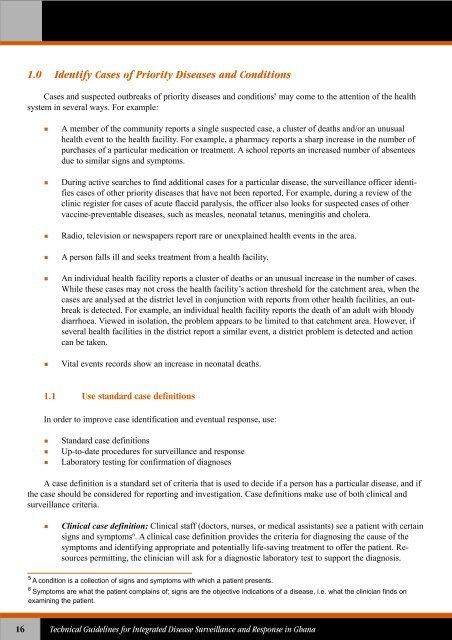Technical Guidelines for Integrated Disease Surveillance ... - PHRplus
Technical Guidelines for Integrated Disease Surveillance ... - PHRplus
Technical Guidelines for Integrated Disease Surveillance ... - PHRplus
You also want an ePaper? Increase the reach of your titles
YUMPU automatically turns print PDFs into web optimized ePapers that Google loves.
1.0 Identify Cases of Priority <strong>Disease</strong>s and ConditionsCases and suspected outbreaks of priority diseases and conditions 5 may come to the attention of the healthsystem in several ways. For example:A member of the community reports a single suspected case, a cluster of deaths and/or an unusualhealth event to the health facility. For example, a pharmacy reports a sharp increase in the number ofpurchases of a particular medication or treatment. A school reports an increased number of absenteesdue to similar signs and symptoms.During active searches to find additional cases <strong>for</strong> a particular disease, the surveillance officer identifiescases of other priority diseases that have not been reported. For example, during a review of theclinic register <strong>for</strong> cases of acute flaccid paralysis, the officer also looks <strong>for</strong> suspected cases of othervaccine-preventable diseases, such as measles, neonatal tetanus, meningitis and cholera.Radio, television or newspapers report rare or unexplained health events in the area.A person falls ill and seeks treatment from a health facility.An individual health facility reports a cluster of deaths or an unusual increase in the number of cases.While these cases may not cross the health facility’s action threshold <strong>for</strong> the catchment area, when thecases are analysed at the district level in conjunction with reports from other health facilities, an outbreakis detected. For example, an individual health facility reports the death of an adult with bloodydiarrhoea. Viewed in isolation, the problem appears to be limited to that catchment area. However, ifseveral health facilities in the district report a similar event, a district problem is detected and actioncan be taken.Vital events records show an increase in neonatal deaths.1.1 Use standard case definitionsIn order to improve case identification and eventual response, use:Standard case definitionsUp-to-date procedures <strong>for</strong> surveillance and responseLaboratory testing <strong>for</strong> confirmation of diagnosesA case definition is a standard set of criteria that is used to decide if a person has a particular disease, and ifthe case should be considered <strong>for</strong> reporting and investigation. Case definitions make use of both clinical andsurveillance criteria.Clinical case definition: Clinical staff (doctors, nurses, or medical assistants) see a patient with certainsigns and symptoms 6 . A clinical case definition provides the criteria <strong>for</strong> diagnosing the cause of thesymptoms and identifying appropriate and potentially life-saving treatment to offer the patient. Resourcespermitting, the clinician will ask <strong>for</strong> a diagnostic laboratory test to support the diagnosis.5 A condition is a collection of signs and symptoms with which a patient presents.6 Symptoms are what the patient complains of; signs are the objective indications of a disease, i.e. what the clinician finds onexamining the patient.16<strong>Technical</strong> <strong>Guidelines</strong> <strong>for</strong> <strong>Integrated</strong> <strong>Disease</strong> <strong>Surveillance</strong> and Response in Ghana















